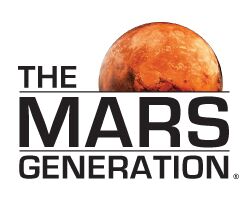Season 3, Episode 6, #AskAbby Space and Science Show: Homeschool Edition
Presented by TheMarsGeneration.org
Could We Live Without Magnetism?!
Subscribe to our YouTube channel here so you don’t miss an episode!
In episode 6 of the #AskAbby Space and Science Show: Homeschool Edition, host Abby Harrison discusses magnetism and why humans actually need magnetism to survive! From protecting us from radiation caused by the Sun’s solar storms to creating a beautiful aurora borealis in the night sky, it’s safe to say magnetism is pretty magnificent!
Abby answers questions posed by Jennie Anderson’s 3rd Grade class at Murch Elementary in Washington D.C. including: How does Earth’s magnetic field protect us from the sun? What is the planet with the most magnetism? Do other planets have a magnetic field too? Why do some planets have magnetic fields and others don’t? Are Earth and Jupiter the only planets with magnetism? Does the sun have any magnetism inside or does it have any iron in the Sun? What types of metal are magnetic?
Transcription of Could We Live Without Magnetism?
ABBY
Hi everyone and welcome to #AskAbby: Homeschool Edition!
This is a new series of AskAbby meant to provide resources–as well as the all-important space puns and space jokes–to students who are now doing distance learning during the COVID-19 pandemic!
Each episode features questions submitted by students from around the world.
This episode is focused on magnetism, and features questions submitted by teacher Jennie Anderson’s 3rd grade students at Murch Elementary School in Washington, D.C.
*INTRO GRAPHIC*
ABBY
Question number one: How does Earth’s magnetic field protect us from the sun?
Earth’s core acts essentially like a giant magnet, and projects a magnetic field around the planet. We call this the magnetosphere. And having a magnetosphere is really important to having life here on Earth because it protects us from the harmful solar wind and solar storms that our sun generates.
Basically our sun sends out waves or blasts of charged particles that carry harmful radiation and could even strip away our atmosphere. Luckily for us the magnetization of our planet’s magnetosphere deflects most of these charged particles away from Earth. You can think of it like how an umbrella deflects rain.
If the sun produces a particularly large solar wind or solar storm, some of those charged particles do make their way through our magnetosphere, and end up interacting with Earth’s atmosphere, which causes…auroras!
Question number two: Do other planets have a magnetic field as well? What’s the planet with the most magnetism?
Yes, of the remaining 7 planets in our Solar System, five of them actually have magnetic fields as well. The four gas giants – Jupiter, Saturn, Uranus and Neptune all have incredibly strong magnetic fields–magnetic fields that are much stronger than Earth’s! And then you have Mercury, which kind of sort of has a magnetic field…it’s a little bit wimpy.
Mercury’s magnetic field is only about 1/100th of the strength of Earth’s. On the other hand, the planet with the most magnetism, and the strongest magnetic field, is Jupiter. Jupiter’s magnetic field is 20,000 times stronger than Earth’s.
Question number three: Why do some planets have magnetic fields and others don’t?
A planet’s magnetosphere is a result of the interaction between the convection of the planet’s interior and the planet’s rotation. And in order to have convection in its interior or core, a planet’s core has to be made up of a liquid. We can use these two positive features to explain the three planets in our Solar System that have little to no magnetosphere.
So let’s start with Mercury, because we already said that Mercury does have a magnetosphere, it’s just not a very good one. And the reason for that is because Mercury is simply rotating too slowly.
After that, we can go ahead and look at Venus, which is rotating fast enough and has a liquid core, but its core isn’t convective, so it can’t create a magnetosphere around the planet.
And finally we have Mars. Mars, once again, like Venus, is rotating fast enough, but unlike Venus, Mars does not have a liquid core…at least not anymore. It’s believed that Mars used to have a liquid core and that over time, it solidified.
Question number four: What types of metals are magnetic?
Ferromagnetic metals like iron, steel, cobalt and nickel. Iron’s actually the metal at Earth’s core that’s primarily responsible for our magnetosphere.
Question number five: Does the sun have any magnetism inside and does it have any iron inside?
The Sun does have iron, but it’s only about 0.14% of the Sun’s total mass. The majority of the Sun is made up of hydrogen and helium, something that was first shown in 1925 by Cecelia Payne-Gaposchkin, who was actually the first woman in the United States to get a PhD in astronomy.
To be completely honest, we don’t know for sure how our Sun’s magnetosphere is formed. But we think that it’s likely that it’s formed as a result of convection of elements like hydrogen and helium that deep within the Sun, are in a state of matter known as Plasma.
Today we learned about magnetism in space. We found out what causes magnetic fields for planets and the Sun, and how these magnetic fields protect us from harmful solar and cosmic particles.
And most importantly, we learned that our own magnetic field is so vital, that we actually wouldn’t be able to have life on Earth without it.
*Talking to fridge magnets* Aww, thanks guys. Gotta appreciate magnets.
Thanks for watching. To send in a question, you can tweet me with the hashtag #AskAbby, or submit it to The Mars Generation website which is linked below.
And until next time, keep safe, keep healthy, and keep learning! So long fellow travelers of spaceship Earth!



Leave a Reply